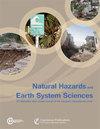法国阿尔卑斯北部激流集水区泥沙供应的统计模型
IF 4.7
2区 地球科学
Q1 GEOSCIENCES, MULTIDISCIPLINARY
引用次数: 0
摘要
摘要了解和预测激流集水区粗沙输运的能力是防范和预防相关灾害的关键因素。在这项研究中,我们收集了描述法国阿尔卑斯山北部99个暴雨集水区沉积物供应的数据。样本涵盖了广泛的地貌活动:从每几年经历一次泥石流的激流到每十年输出少量河床负荷的完全森林集水区。这些集水区对过去的事件和碎屑盆地的沉积物供应有很长的记录。得到了各流域的年平均供沙量、10年回收期和参考量(即100年回收量或最大观测量)。我们使用线性回归和随机森林方法研究了特定泥沙供给量与许多解释变量之间的关系。结果表明,供沙面积(裸露土壤或岩石)与集水区面积之比是比产沙量(m3 km−2)最重要的预测因子。其他变量,如梅尔顿指数或沉积物连通性指数也有影响。建立了几种预测模型,以估计不带碎屑盆地的激流的泥沙供给。本文章由计算机程序翻译,如有差异,请以英文原文为准。
Statistical modeling of sediment supply in torrent catchments of the northern French Alps
Abstract. The ability to understand and predict coarse-sediment transport in torrent catchments is a key element for the protection against and prevention of the associated hazards. In this study, we collected data describing sediment supply at 99 torrential catchments in the northern French Alps. The sample covers a wide range of geomorphic activity: from torrents experiencing debris flows every few years to fully forested catchments exporting small bed load volumes every decade. These catchments have long records of past events and sediment supply to debris basins. The mean annual, the 10-year return period and the reference volume (i.e., the 100-year return level or the largest observed volume) of sediment supply were derived for the studied torrents. We examined the relationships between specific sediment supply volumes and many explanatory variables using linear regression and random forest approaches. Results showed that the ratio of sediment-contributing area (bare soil or rock) to catchment area is the most important predictor of the specific sediment production volumes (m3 km−2). Other variables such as the Melton index or the indices of sediment connectivity also have an influence. Several predictive models were developed in order to estimate the sediment supply in torrents that are not equipped with debris basins.
求助全文
通过发布文献求助,成功后即可免费获取论文全文。
去求助
来源期刊
CiteScore
7.60
自引率
6.50%
发文量
192
审稿时长
3.8 months
期刊介绍:
Natural Hazards and Earth System Sciences (NHESS) is an interdisciplinary and international journal dedicated to the public discussion and open-access publication of high-quality studies and original research on natural hazards and their consequences. Embracing a holistic Earth system science approach, NHESS serves a wide and diverse community of research scientists, practitioners, and decision makers concerned with detection of natural hazards, monitoring and modelling, vulnerability and risk assessment, and the design and implementation of mitigation and adaptation strategies, including economical, societal, and educational aspects.

 求助内容:
求助内容: 应助结果提醒方式:
应助结果提醒方式:


